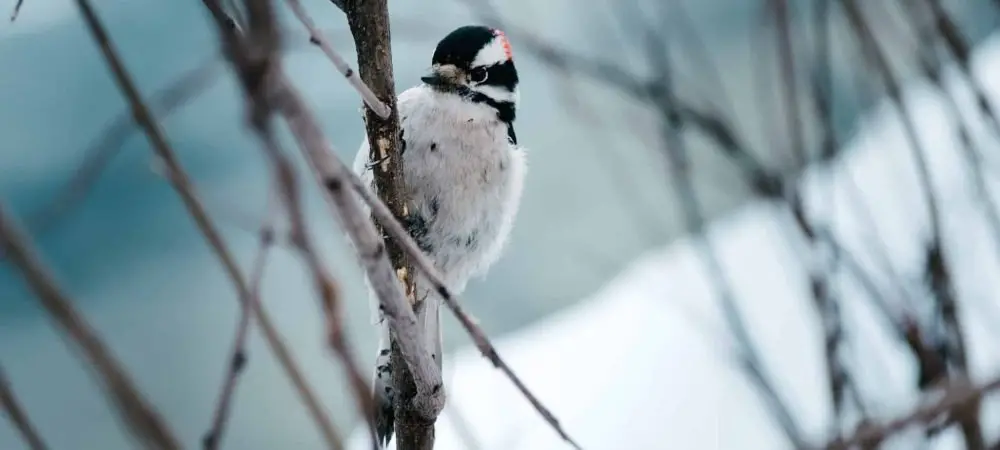
In Minnesota, there are 11 different species of woodpecker that you may encounter. These woodpeckers are:
- Williamson’s Sapsucker
- Yellow-Bellied Sapsucker
- Lewis’s Woodpecker
- Red-Headed Woodpecker
- Red-bellied Woodpecker
- American Three-toed Woodpecker
- Black-backed Woodpecker
- Downy Woodpecker
- Hairy Woodpecker
- Pileated Woodpecker
- Northern Flicker
Want to learn more? Take a look at the North American Guide to Woodpeckers
Minnesota has a continental climate which means that the winters are cold and often harsh whilst the summers are very hot and humid. There are 66 state parks across Minnesota and there are 6 national parks across the state.
After briefly looking and the state and woodpeckers that reside there, let’s have a look at the different woodpeckers you may find in Minnesota.
Take a look at our article on How to Attract Woodpeckers?
What Woodpeckers can be seen in Minnesota?
Table of Contents
1. Red-bellied Woodpecker
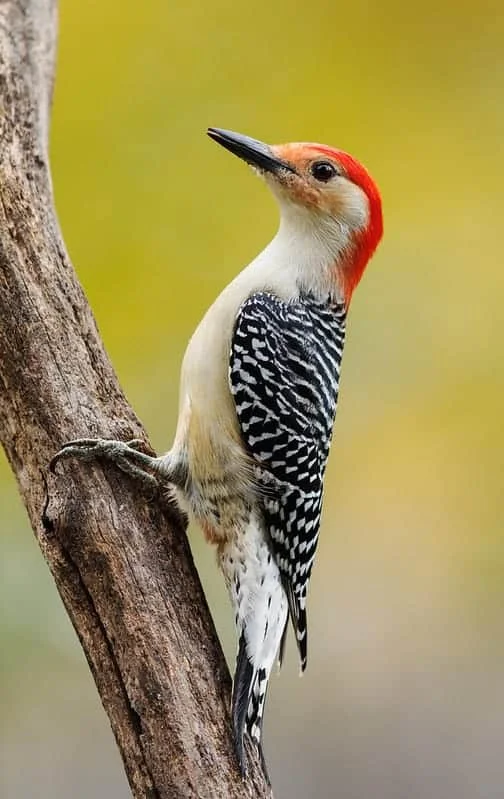
Wingspan
15-18 inches
Weight
2.65 ounces
Life Expectancy
12 years
Diet
Insects
These woodpeckers have much brighter red feathers on their crown of their heads compared to the pale red feathers of their bellies. Black and white feathers form striping patterns down this woodpecker’s back.
You can find these birds in both woodland areas in wooded suburb areas. Males will pick a site for the nest and begin to excavate it early on in the breeding season, their nests are usually in dead trees and trunks.
To initiate courtship, males will tap on their tree trunks to from inside of the cavity to attract a female and if the female is interested, she will tap back to the male. They will make their nests in the same tree year after year but will often use a different cavity, they lay about 2-6 eggs per brood.
Their range is large across the eastern states and covers the whole of Minnesota. They can be seen in the state throughout the whole year and they are most commonly seen in the south of the state.
They are most active during the breeding season and least active in winter.
2. Downy Woodpecker
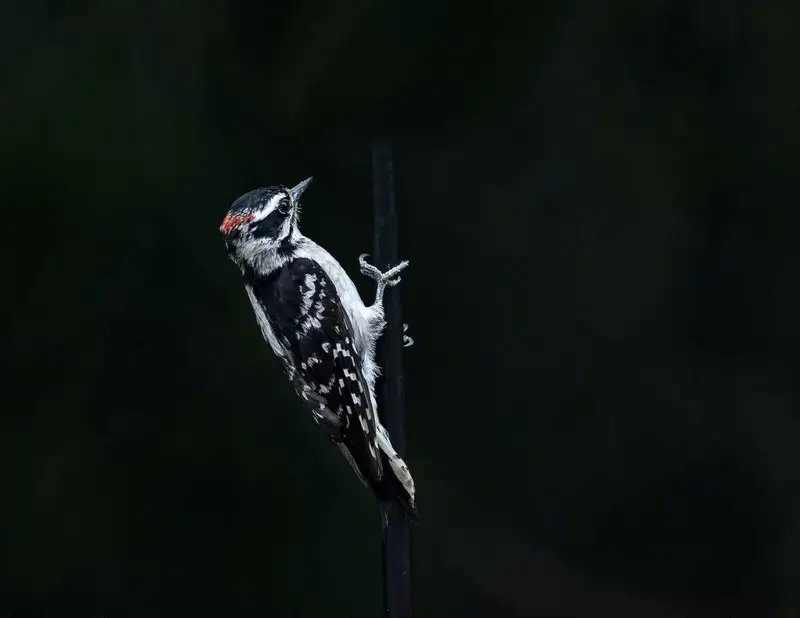
Wingspan
3.27 to 4.13 inches
Weight
0.75 to 1 ounce
Life Expectancy
12 Years
Diet
Insects & Non-insect arthropods
These small woodpeckers can be identified by the tiny patch of red on the back of their heads and their pales bellies and dark wings and backs. You will usually find this woodpecker close to rivers and streams in open woodlands areas.
The beginning of the breeding season is in the early spring months and males will try to attract females by flying between trees and fluttering their wings to look almost like a butterfly.
The breeding pairs nest together and will nest in either fully dead trees or in the dead parts of living trees.
These woodpeckers have a large range and can be seen throughout the whole of Minnesota. As well as this they are year-round residents of the state. Most of the recorded sightings of this bird have been to the east of the state.
3. Hairy Woodpecker
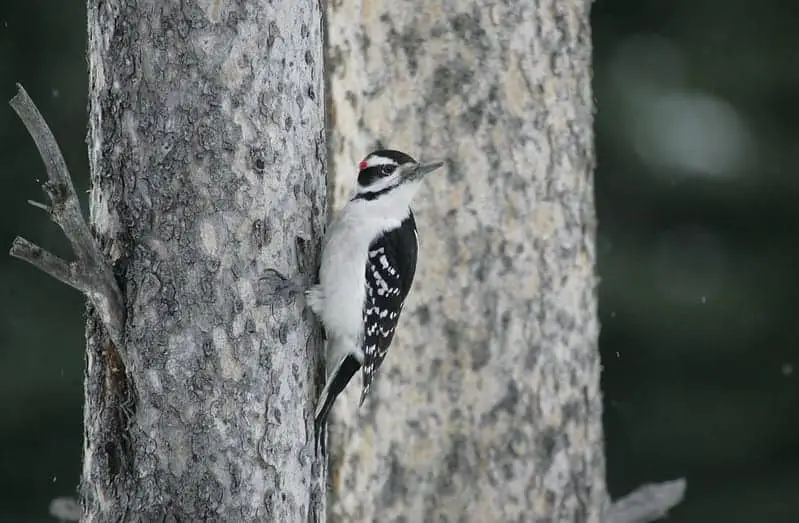
Wingspan
15 inches
Weight
1.4 to 3.4 ounces
Life Expectancy
15 years
Diet
Wood-boring insects & tree sap
These woodpeckers are most uniquely identified by the orangey red patch of feathers on top of their head and they are medium in size for a woodpecker. They also have pale bellies and dark wings and backs.
These birds will make their nests in cavities of dead trees, often hollowing out a new one each year, which is a common practice for woodpeckers. They like to nest in woodland areas and their broods consist of 3-6 eggs, they only have one brood per year.
Males have a specific conflict display that they do to other males of the species. They raise their wings over their back and make a shrill cry to warn to other individual that conflict may ensue.
They also have a unique courtship display for the females, but this and their other breeding behaviours have not been well studied.
These woodpeckers are very abundant across Minnesota. They can be seen throughout the whole year and across all state regions.
The highest number of sightings have been in the north of the state and are usually during the breeding seasons.
4. Pileated Woodpecker
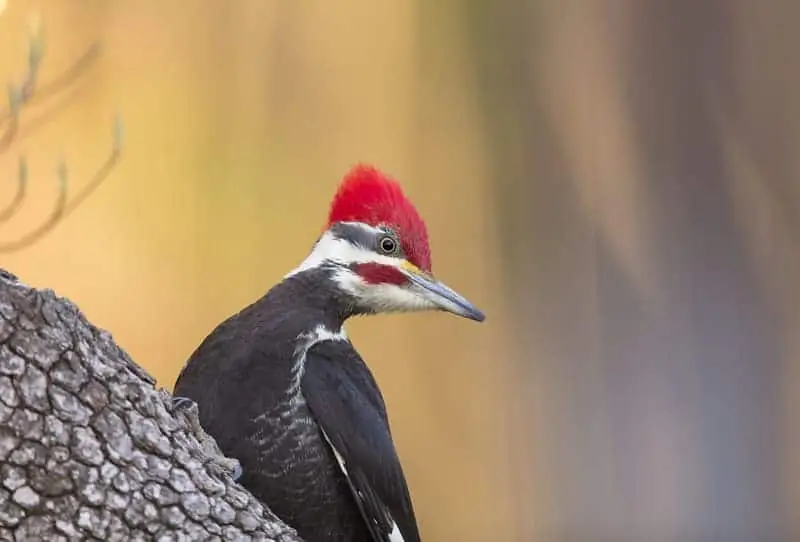
Wingspan
26 to 30 inches
Weight
8.8 to 14.1 ounces
Life Expectancy
13 years
Diet
Fruit, nuts & insects
These woodpeckers can be identified by their bright white neck and the prominent display of red feather on top of their heads. The rest of their bodies are covered in dark black feathers.
These birds make their nests in mature woodlands, usually coniferous woodlands if they can, and they are large for a woodpecker. Their make their cavities in dead trees and trunks and they are rectangular in shape, which is not common for woodpeckers.
These birds remain monogamous and often breed for life, they only allow another individual into their territory when their mate dies. This means that there are a lot of Pileated Woodpeckers that do not have their own territory and have to wait to take a deceased’s place.
These woodpeckers can be seen in Minnesota throughout the whole year, but they are not present in all regions of the state. They can be seen to the north of the state and along the eastern border.
5. Yellow-bellied Sapsucker
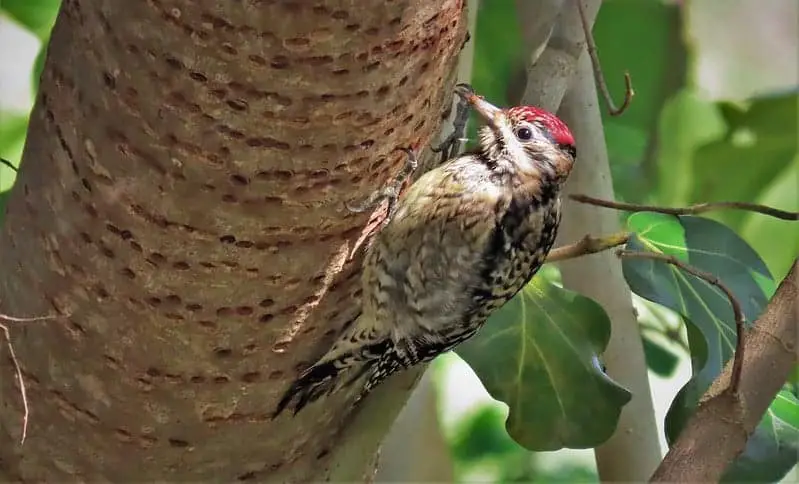
Wingspan
13 to 16 inches
Weight
1.5 to 1.9 ounces
Life Expectancy
7 years
Diet
Tree sap, insects & fruit
Yellow Bellied-Sapsuckers have bold black and white feather patterns and are identifiable by their red crowns, they have pale yellow feathers on their bellies which is where they get their names.
These birds are small in size for woodpeckers and have a stout bill. These birds will be found nesting in different forests depending on the seasons. The Yellow-bellied Sapsucker has both courting displays and aggressive displays that are very similar to one another.
The biggest difference is that aggressive displays are done to members of the same sex. These birds will form long term breeding pairs, although a few will find different mates every year. They remain monogamous throughout the breeding season.
These woodpeckers are not permanent residents of Minnesota and are only present in the state during their migration and occasionally in their breeding seasons.
The most commonly recorded sightings of these woodpecker have been to the east of the state.
6. Northern Flicker
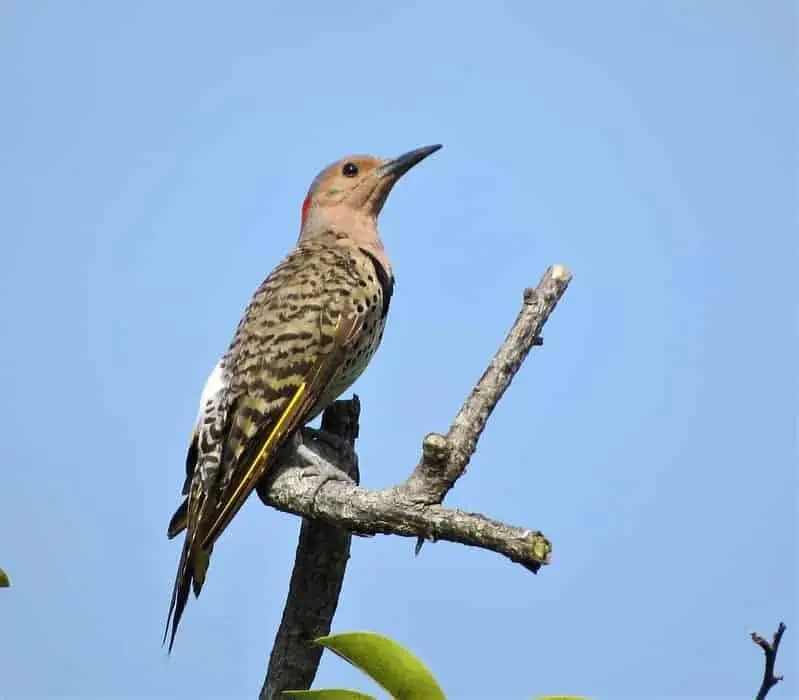
Wingspan
21.3 inches
Weight
6 ounces
Life Expectancy
9 Years
Diet
Insects, seeds, nuts & fruit
These brown feathered woodpeckers are very large in comparison to other woodpecker species and they have a unique pattern of spotted bellies and they have distinct patches of red on their face and their tail.
These birds will sometimes nest in city parks and suburbs but prefer to mostly stay in more dense wooded areas. These birds spend most of their time foraging for food on the ground which is not common for woodpeckers.
Two males will sometimes compete in what is called a ‘fencing duel’ and they will do this display whilst emitting a call that sounds like wicka. They will do this display in the presence of a female to try and get her to mate. these birds will reuse the cavities that they have excavated in previous years, although it is not known whether they return to the same mate every year.
The range of this bird encompasses all of Minnesota and they can be seen year-round.
The highest abundance of recorded sightings has been in the central regions of the state but they are relatively easy to find in any region in Minnesota.
7. Lewis's Woodpecker
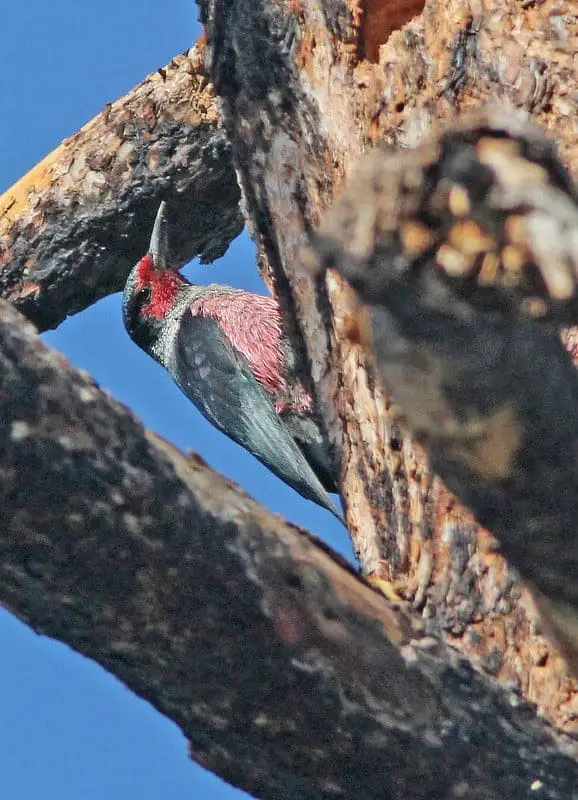
Wingspan
11 inches
Weight
4 ounces
Life Expectancy
4-11 Years
Diet
Insects & Nuts
This is a medium sized woodpecker which has feathers that in the light you can see that the wing feathers are a greyish green and that this bird has a pale pink belly.
Out of light the feathers are very dark and colours are indistinguishable. These birds like to breed and nest in pine forests, particularly less dense and more open ones if possible. In the winter they will eat acorns and nuts whilst in the summer they will primarily feed on insects.
This species of woodpecker is particularly aggressive and will often confront other species of woodpecker such as the acorn woodpecker. Not a lot is known about the mating habits of this bird, but it is known that males will circle around their nesting tree to attract a female.
These woodpeckers are not common residents in Minnesota and there have only been a few recorded, scattered sightings, usually outside of their breeding seasons. The most common recorded sightings have been to the south east of the state.
8. Red-headed Woodpecker
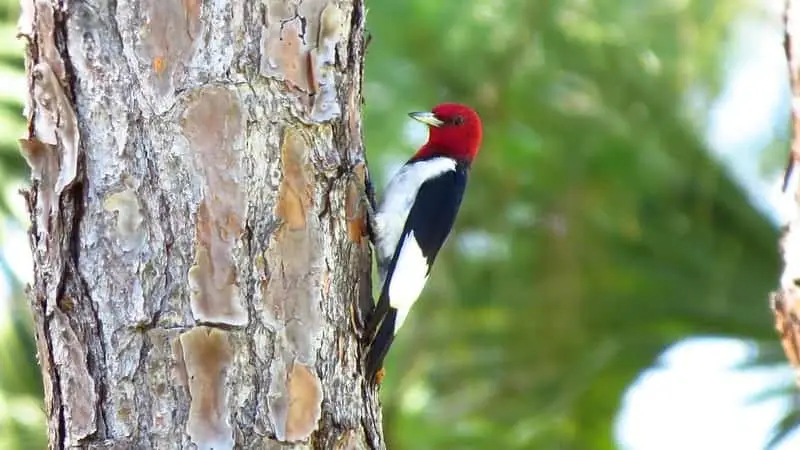
Wingspan
16 inches
Weight
2.5 ounces
Life Expectancy
9 Years
Diet
Insects & Berries
The Red-Headed Woodpecker, unsurprisingly, has a bright red head, which is also its most easily identifiable feature. A combination of white and grey feathers covers the rest of this bird’s body.
These birds are medium sized for a woodpecker and spend most of their time in dense woodland areas. Breeding pairs will play a game of hide and seek with one another around tree stumps at the beginning of the breeding season when they are first courting.
These pairs do not interact with each other outside of the breeding season, but they will often stay together for several years. They are predated upon by a lot of different species including raccoons and Peregrine falcons, both individuals from the breeding pair will help to defend the nest and they are very territorial, even outside of the breeding season.
These woodpeckers can be seen all across the state of Minnesota but are not found there year-round. They can only be seen during the breeding seasons and the most commonly recorded sightings have been to the north of the state.
9. American Three-toed Woodpecker
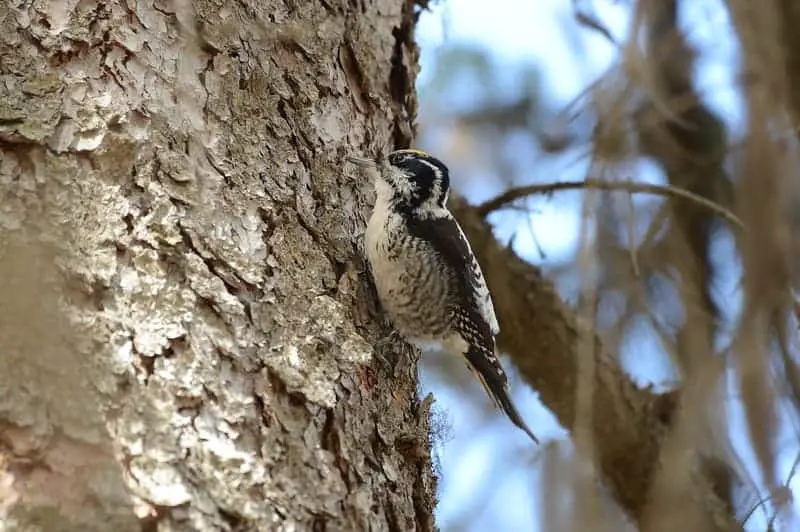
Wingspan
15 inches
Weight
2 ounces
Life Expectancy
6 Years
Diet
Beetle Larvae, insects & fruit
The American Three-toed woodpecker is small and stout in size and has a distinct yellow patch of feathers on top of its head. The rest of its body is covered in black and white feathers.
These woodpeckers are found usually in more mature forests and they will nest in boreal and mountain forests. These birds are solitary throughout most of the year and will only socialise during the breeding season with their mate.
Breeding pairs will mate for several years together and they are monogamous in the mating season. Both individuals from the pair will help make the cavity, take care of the eggs and help raise the young.
Whilst these woodpeckers are not common in Minnesota, they can be seen in the state throughout the whole year. Their range only extends throughout the northeast of the state but there have been a few recorded sightings along the eastern border of the state.
10. Black-backed Woodpecker
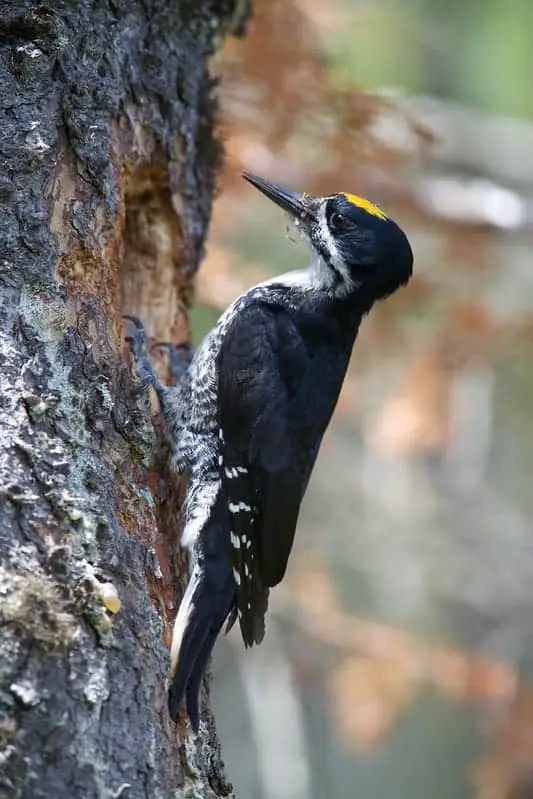
Wingspan
16 inches
Weight
2.5 ounces
Life Expectancy
8 Years
Diet
Wood-boring Beatles, fruit & nuts
The Black-Backed woodpecker has, as you would expect, a black feathered back. These black feathers also cover its wings and head. Its belly is a bright white colour.
They are medium is size and have a large head compared to their body. These woodpeckers like to nest and stay in coniferous forests and are most commonly found in recently burnt areas of forest.
The size of this bird’s territory depends on the food abundance in the area. Like some other woodpecker species, their courtship and conflict displays are very similar to one another. Both individuals in the breeding pair will help incubate eggs and raise young.
Some of these breeding pairs will also interact with each other outside of the breeding season and most of them will mate for several consecutive years.
These woodpeckers only have a small range across the united states. They cannot be seen throughout the whole of Minnesota but they can be seen here throughout the whole year.
The range has been recorded to the north east of the state, but there has also been quite a few numbers of recorded sightings in the central areas of the state.
11. Williamson's Sapsucker
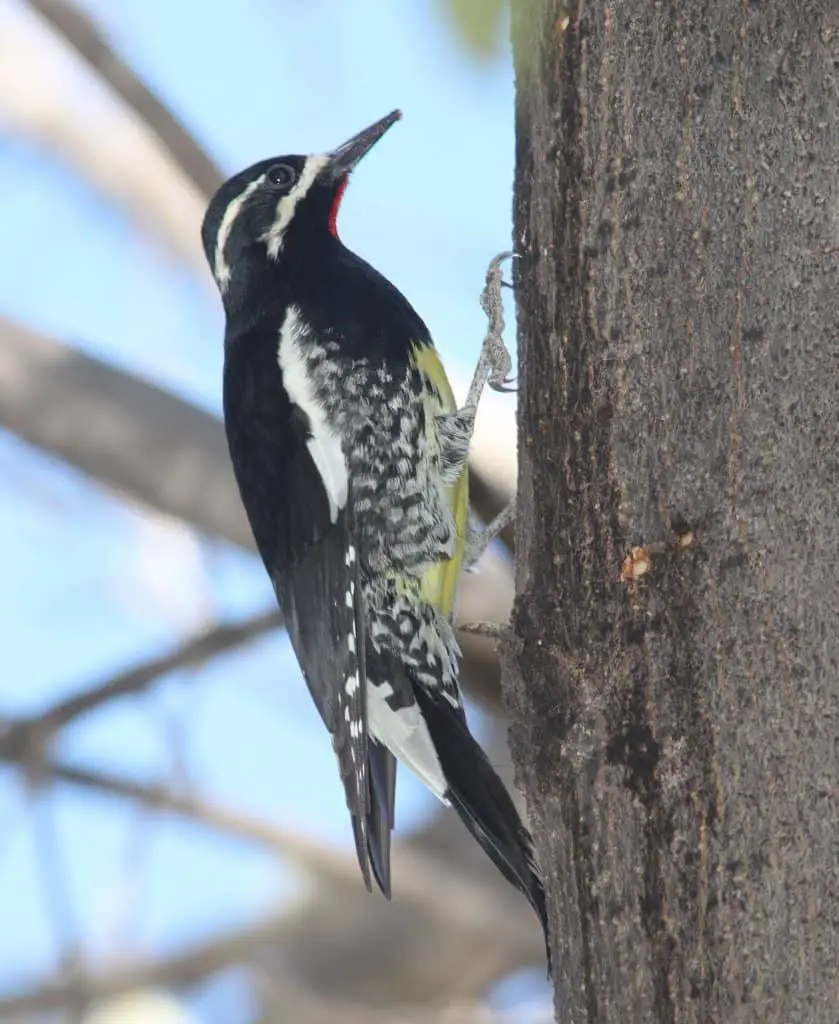
Wingspan
13.4-15.8 inches
Weight
44-55 g
Life Expectancy
7 Years
Diet
Sap
The Williamson’s Sapsucker is largely covered in black and white feathers and is medium in size. They have bright yellow feathers that cover their bellies, but this is only in the males.
These woodpeckers are most commonly found in coniferous woodlands, but will sometimes be in other wooded areas. Males have a territory area of up to 10 acres and they are very territorial with other male woodpeckers and they are even more defensive during the mating season.
Williamson’s Sapsuckers will form long term breeding pairs and are monogamous during the breeding seasons, whilst others will find a different partner in the continuing years. Pairs will raise the broods together and only part after their young have fledged.
Williamson’s Sapsuckers are one of the least common woodpeckers to be seen in Minnesota. They are much more common to the west of the states but will sometimes be in Minnesota in their breeding seasons. The only recorded sightings of this bird in Minnesota have been to the south west of the state.

More Articles.
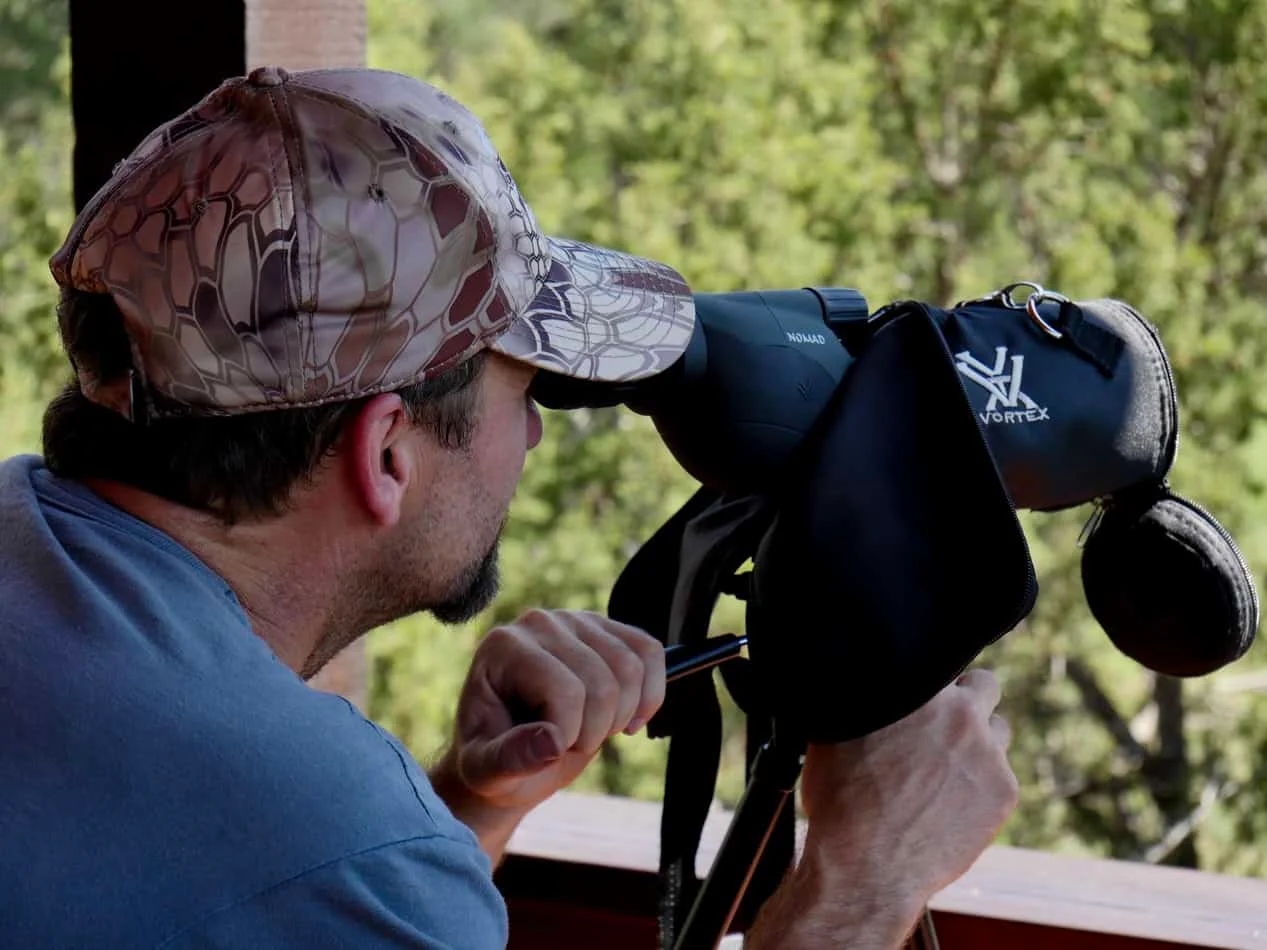
Best Spotting Scopes for Birding 2020
When it comes to birdwatching, you want to make sure that you have the right
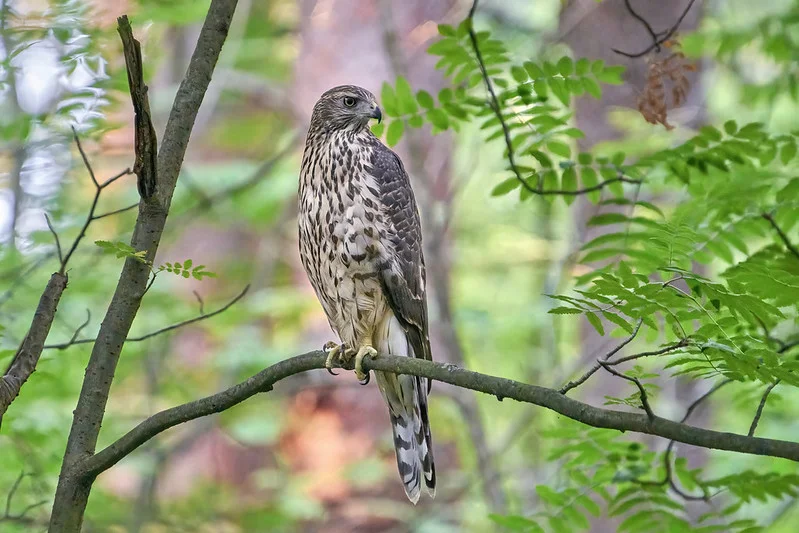
What Hawks can you see in Germany? (3 Species with Pictures & Sounds)
What Hawks can you see in Germany? There are 3 different species of Hawks that
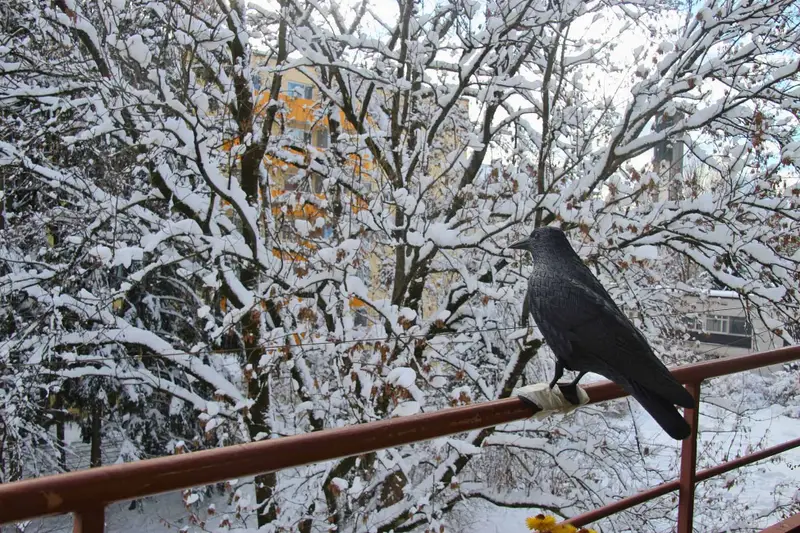
How to Attract Birds to a Window?
All birds can be attracted to a window feeder. Some will require bright colors to

About Us
We are avid bird-watchers who recently retired, allowing us more time to travel the world. Fortunately, we have managed to visit numerous countries around Europe, Asia, and America. Watching and photographing birds has been a passion for many years and we are making the most of the extra time on our hands!
